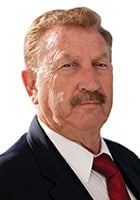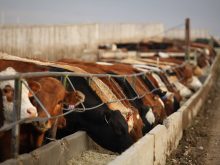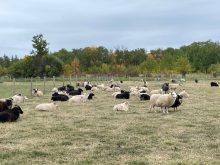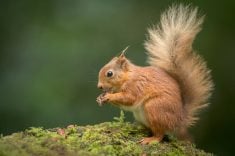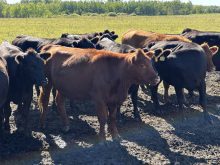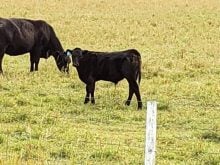The cattle breeds I knew as a teenager are gradually disappearing. When it comes to milk breeds, we have essentially one type of cow, the black and white Holstein, which makes up 94 per cent of Canada’s dairy herds. Holstein is a misnomer in my thinking since in Wales we called them Dutch Friesians.
I remember I ate many a steak in Germany in 1961 proudly proclaimed as Holstein beef. I thought of them as dual-purpose cattle. I remember working on Friesian farms in Wales and the cows there seemed much shorter than the present-day Canadian Holstein/Friesians.
When it comes to beef cattle, it seems to be Angus and Angus. As far back as 1965, I was invited to a steak meal at an Angus steak house in Jacksonville, Fla. In other words, Angus beef promotion began more than 60 years ago.
Read Also

Gentle treatments for pain in the neck
Heading toward year-end, people unknowingly tense up against the cold and busyness, causing neck pain that can often be treated with appropriate support and gentle mobility, athletic therapist Kathlyn Hossack says.
Canada has around 33 registered beef breeds and many more unregistered ones. Amongst beef breed registration there are differences such as black, red and German Angus. Red Angus is not recognized in the United States.
Checking the recent beef cattle registrations in Canada (2019), the registered breeds total 118,816 cattle, of which 56,003, almost 50 per cent, are Angus. The next breeds that have major numbers are Simmental at 22,068, Charolais at 14,845, Hereford at 12,002, Shorthorn at 2,616 and Speckle Part at 1,382. All other beef breeds are in the low hundreds or less.
The four western provinces account for more than 80 per cent of Canadian beef cattle. Beef farms make up a quarter of all farms in Canada carried on some 60,000 cow-calf farms from coast to coast and, along with dairy farms, they amount to 12.5 million head at any given time.
Dairy farms number around 20,000, with an average of 54 cows per farm. Aside from the 94 per cent Holstein/Friesian dairy cattle, we have four per cent Jersey and one per cent or less of Brown Swiss, Guernsey, Ayrshire and Shorthorn.
The western provinces, including British Columbia, account for 80 per cent of Canada’s beef breeds with nearly 50 per cent of this total in Alberta.
My experiences in Wales
The small farm where I grew up in the 1940s and ’50s, some 70 to 80 years ago, was only 17 acres, with access to additional grazing. Due to the year-round, mild, wet climate, we stocked 15 to 20 cattle annually. Most were beef breeds with two to three milking cows.
Cows in those days were milked by hand twice a day. The milk that didn’t go for food or calves was placed in large pans and skimmed for cream daily. The fat-free milk was then fed to hogs or poultry with unlimited amounts to the farm’s dogs and cats. I believe now that farm dogs, like collies and corgis, and farm cats were lactose tolerant from years of farm selection.
Later on in the 1950s, we purchased a milk separator that divided the cream from the milk. The accumulated cream was periodically churned by hand into butter, which could take 30 minutes to two hours or more of work before forming butter.
One thing we forget is fresh milk could turn sour in two days even at cool temperatures. Now with pasteurization, milk does not even separate into skim and top cream, and it remains fresh and sweet when refrigerated for up to two weeks.
We really do not understand how well off we are with our dairy industry. It was not uncommon in the “good ol’ days” to meet individuals who suffered from either brucellosis or bovine tuberculosis caught from infected cattle. Milk cows that were infected with tuberculosis (TB) could, if the ovaries were infected with this disease, stop milking and take on male characteristics. I even found cows that gave birth to twins of both sexes, the female was sterile and referred to as a freemartin.
I am at a total loss, in this day and age, why some people are clamouring for “raw milk.” Canadian cattle, both beef and dairy, are the healthiest in the world.
When it comes to beef cattle, every owner believes they have by far the best beef breed. What beef breeders have done in Canada is to take the British beef types and crossbreed them with bigger, meatier, European breeds, which were often cattle that in past years were often used as draft animals. Most beef animals now seem to have the same profile.
In the small farm where I lived, we would have a range of beef cattle types and beef/dairy crosses. I quickly learned as a teenager never to carry a small, 50-pound bale of hay into a herd of cattle unless you wanted to get trampled. I also found that when you medicated cattle with bottled drenches that they have very sharp upper and lower teeth in the back of the mouth.
My father was a “jack of all trades” and a master of them all. He even knew how to cure bloat with a sharp knife and help cows with difficulties when giving birth.
He did make one error of judgement. He had three Jersey/Hereford bull calves vasectomized instead of the usual castration. He thought they would gain weight faster. At 18 months all three became aggressive bulls that intimidated anyone walking near them. The only control method for them was two Welsh corgi dogs that had these young bulls fully tamed. These bulls were sold early. No more vasectomies.
When cows came into heat (season) in my early teens, we had to walk them to a farm with a registered breeding bull. For our cows, this was about a mile or so away. The older cows knew the way.
We had a Shorthorn type that produced 15 calves. For them, we’d put a halter on the cow with a six-foot rope trailing, get out a bicycle and a big stick, and make sure the border collie was available.
Traffic in those days was rare — there were only four cars and two trucks in a nearby village of 3,000. The stick and the border collie were to keep stray dogs away on the journey to the bull, and the bicycle to help if the cow ran rather than walked. Those were “the dull old days.”
When I was around 14, relief came with AI (artificial insemination) on order with travelling fertility specialists. They were called locally amongst the farmers, “the bull with the bowler hat.”
My father did not like Aberdeen Angus as they were on the small side, easily spooked and always found holes in fenced fields. Welsh blacks were out since both sexes with horns looked like Spanish fighting bulls — but were first-class beef animals.
Hereford cattle were the favourites. It might surprise many of you that they were Welsh cattle from the Vale of Glamorgan (southern Wales). There were white- and brindle-faced types. Maureen O’Hara and the English just enjoyed the beef. The Welsh herders drove the Herefords to the town of Hereford, on the English border, for sale.
Another cattle peculiarity I came across in my teen years was while I worked as a turkey killer on what really was a dairy farm, the owner never kept the first female calf of a Friesian. It was sold to the beef calf trade along with the surplus males.
I bought two of these females over a couple of years and brought them home. For killing and partially feathering turkeys, I was paid two shillings and six pence an hour. The cost of turkey meat at that time was two shillings and six pence a pound. I took a 32-pound turkey home one Christmas, which was 32 hours of work! Both female calves combined cost less than the 32-pound turkey.
In my late teens, my father sold each of these Friesians as second calvers at the local farmers mart for around twice the price that he would have got for a local, run-of-the-mill, milk cow. His smile coming back from the mart each time, according to my mother, was as wide as the room. I was away at university at that time.
Ayrshire cattle (from Scotland) were good milk-producing cows but temperamental and difficult to milk by hand. The calves were not well regarded since the complaint was that the beef was too pale and the fat much too yellow. An Ayrshire steak that I had some years later was of excellent quality and taste.
All I can say about the dairy and, particularly, the beef breeds, is that through crossbreeding we are headed to the blended animal. The dairy cow with all of the best traits of the milk speciality breeds both in milk yield and quality, calving ease and relative longevity.
The beef breeds are not really purebreds when you think of the few hundred, purebred, old type Aberdeen Angus left in Scotland, with the millions of Angus on the North American continent in both Canada and the United States. It’s the consumer, the butcher and the retailer who determine the breeds and the meat-producing capabilities.
Every beef breed is the best breed but the trend seems to point to eventually all being black Angus, just like the dairy industry, which has reached the point where they are virtually all black and white Holstein/Friesians.
Here’s some food for thought: I said that I was good at making decisions. I did not say the decisions I made were always good.

